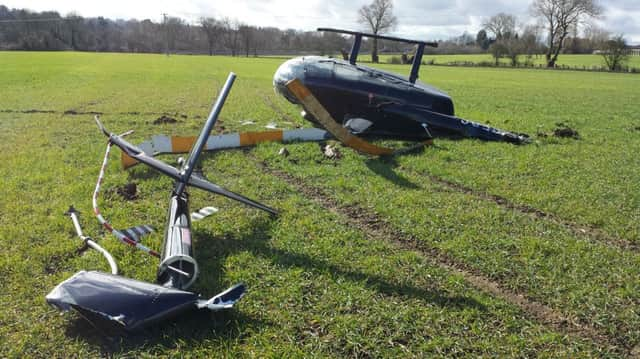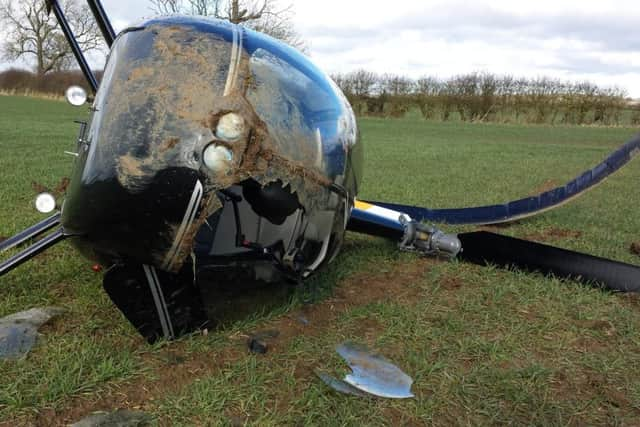Pilot and passenger walked unscathed from wrecked helicopter


But a question mark remains, following an official air crash report today, over the reason the engine of the Robinson R44 owned and flown by Paul Joseph Barnes of Weathercock Lane, Woburn Sands, gave out - forcing Mr Barnes to attempt an emergency landing
The report hints, but comes to no conclusion, that ice forming in the carburettor could have been the cause.
Advertisement
Hide AdAdvertisement
Hide AdThe crash, in which the helicopter ended up rolling over, happened on the morning of February 25.


Today’s Air Accident Investigation Branch report into it says the 69-year-old pilot, who had 1,632 hours flying experience was in a ‘cruise climb’ shortly after take-off in the 2006 built helicopter – G CEDG – when the engine began to run roughly when it was around 800 feet above the ground.
The report stated: “The pilot switched off the governor to control the engine speed manually and initiated a precautionary landing.
“However, he believes the engine then failed and, during the subsequent autorotative landing, the helicopter rolled onto its side.”
Advertisement
Hide AdAdvertisement
Hide AdIt adds: “At the time of writing, there is no hard evidence of an engine or governor fault but it was noted that the weather conditions were consistent with a risk of serious carburettor icing at any power.”
The day before the crash Mr Barnes had collected the helicopter from Sywell Aerodrome and re-positioned it at a private air strip near Salford, Bedfordshire.
However the report says that on starting the engine for that flight there were problems and Mr Barnes sought technical advice. When the engine started again though it appeared normal so he continued with the flight to Salford.
The report continues: “The next day, as planned, he boarded the helicopter with two passengers and a small
Advertisement
Hide AdAdvertisement
Hide Adamount of baggage for a flight to a hotel near Forest Row, East Sussex.
“The engine start and takeoff were both uneventful and the pilot established a cruise climb profile as he set off en route.”
But problems began at 800 ft with the engine ceasing to run as it should and the emergency landing was initiated.
“On touchdown, the helicopter slid forward about 3 m before the skids dug into the ground
Advertisement
Hide AdAdvertisement
Hide Adand it rolled onto its left side. The pilot and one of his passengers exited via the right side
doors whilst the other passenger kicked a hole in the windscreen,” says the report.
The report says the pilot considered that there was a problem with the engine’s rpm followed by an engine failure.
On the question of ice in the carburettor being a possible cause the report says: “It was noted that the
Advertisement
Hide AdAdvertisement
Hide Adweather conditions were conducive to ‘serious icing – any power’ according to the official
chart on risk of carburettor icing published by the CAA.
“The pilot does not recall whether he had applied carburettor heat as he reduced power, but probably had not done so due to the rapid development of events.”